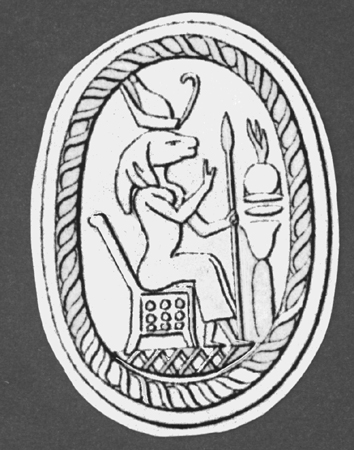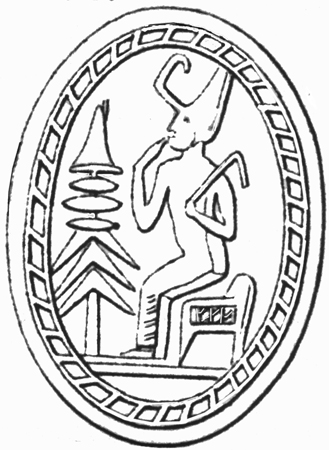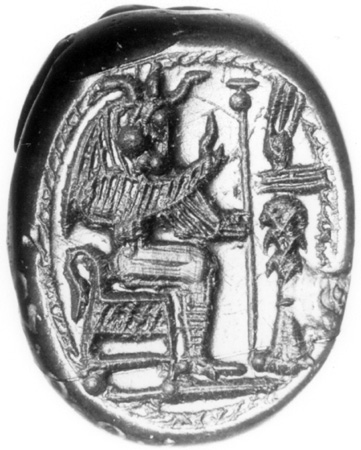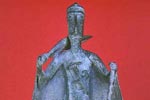-
SaCraba.
User deleted
Antica eclissi solare nel testo astronomico ugaritico KTU 1,78 CITAZIONETRANSLATING, THEN INTERPRETING THE TEXT:
btt ym hdt, hyr `rbt, sps tgrh, rsp
btt=Sixth, sixth hour
ym hdt = day of new moon
hyr=Hiyarru
Meaning an eclipse occurred in the sixth hour on the day of the new
moon of Hiyyaru.
rbt=enter (sexually)
sps=Sun
tgrh= HER gate, meaning Hathor's gate/vulva at sunrise
Rsp=Reshep, Taurus
Meaning the sun entered Hathor's gate in Reshep, meaning the sun rose
in Taurus.
http://tech.dir.groups.yahoo.com/group/Bib...omy/message/230
The KTU 1.78 astrotext is an interesting text with its own reservations but
all considered is likely our best reference for an "absolute" dating for the
Egyptian timeline. "Absolute dating" only comes from astronomical texts and
there are no critical astronomically dated events in early Egyptian history
to anchor the timeline.
The circumstance of this text is that it is the only astronomical text found
at Ugarit but the surface was charred confirming it was in a fire. A fire
at Ugarit was reported in the 12th year of Akhenaton. The nature of the
text, which also contained a liver reading suggests it was "current" a well
when you consider the absence of any library of astronomical texts. The
circumstance of this particular eclipse is what might have prompted the
liver reading since eclipses were "read" as good or bad omens for various
nations depending upon precisely where the eclipse began (i.e. top third,
middle, bottom third). This particular eclipse which occurred in the
"sixth" hour (between 5:00 a.m. and 6:00 a.m.) was apparently already in
progress so precisely where the eclipse began would not have been seen,
prompting the liver reading to find out if this was a good or bad omen for
Ugarit. The liver reading turned out "bad".
The question here is whether a text of this nature would have been "saved"
for any period of time past the immediate relevancy of the eclipse itself.
Because of this "circumstantial" factor though, it becomes a potentially
good dating reference if this was the same/year time as that fire reported
in year 12 of Akhenaton. The text is so specific though. The hour, day,
month, and sun rising in "Reshep" (Egyptian reference to "Taurus" the
"Bull/Lord of Heaven") can only be dated to 1375BCE. It is one of the most
absolutely dated references in all of ancient history as far as astronomical
texts go. That being the case though, dated to year 12 of Akhenaton, the
earlier dating for Akhenaton would be absolute-dated 8 years earlier to
begin his reign in 1386BCE. The earlier dating had his rule beginning in
1378BCE. So this is not far from where he is already dated in this case
other than it preferences the earlier dating than the popular later dating
that has his rule beginning around 1351BCE.
L.W.
www.historykb.com/Uwe/Forum.aspx/an...aton-to-1386BCECITAZIONEReshep "Il Toro del cielo" (dio egizio di origine semitica,sposo della dea,anch' essa semitica,Qadesh)
(....)RSP/Reshap is a reference to Mars. But as noted, a reference to a
planet is awkward with any significance to an eclipse event,
especially since the zodiac house is far more fundamental. So the
question is whether or not Reshep is an appropriate reference to the
zodiac house this eclipse occurs in, which is Taurus.
Please understand that, indeed, Reshep could be a reference to Mars
and still be a reference to Taurus. Gods and goddesses identified
with both constellations as well as planets, as in the case of VIRGO,
the virgin mother goddess also being associated with Venus. But
given a clear-cut choice between a casual planetary association
rather than the zodiac house of occurrence, Reshep is far more
fundamental as a reference to TAURUS.
It is thus after the fact when comparing the imagery of Reshep, its
associations in the Egyptian pantheon and the general concept of the
god in comparison to the imagery, associations and titles of Taurus
that we find consistent overlapping. For instance, the title used
for Reshep in Hyksos-period Egypt was "Lord of Heaven" which is the
title of Taurus which was also "Lord of Heaven" only translated
as "Bull of Heaven." Lord, which is Bel/Baal also means bull. So
the precise title alone associates Reshep with the bull of heaven.
There is also iconography of Reshep via his Syrian crown combined
with the tassel of a bull and a bull's head in some of the Egyptian
iconography that is a direct association between Taurus or the "Bull
of Heaven" and Reshep as the angry god. So it would not be at all a
surprise if at Ugarit Reshep was used as a designation of Taurus.
Reshep was considered a bull and so there's a natural connection.(.......)
http://tech.dir.groups.yahoo.com/group/Bib...omy/message/230
Edited by SaCraba - 14/7/2010, 21:12. -
.
lo scarabeo è dello stesso tipo di quelli ritrovati a cabras, con l'identico incensiere... In Sardinia esiste anche fisicamente (in arenaria o calcare) scambiato spesso per... MODELLINO DI NURAGHE. 
 .
. -
SaCraba.
User deleted
 hai ragione Leo,ho controllato gli scarabei di Tharros e ne ho trovato uno molto simile,c'è ne sono anche con l'incensiere di cui parli
hai ragione Leo,ho controllato gli scarabei di Tharros e ne ho trovato uno molto simile,c'è ne sono anche con l'incensiere di cui parli
da "Bullettino archeologico sardo" di Spano.CITAZIONEBull-headed god seated on a Winged Sphinx throne (understood by some scholars to be a Cherubbim throne), with raised hand for a benediction/blessing, staff in other hand. Incense burned before him. He wears the White crown of Pharaoh with a tassel, rather like the crown worn by the Late Bronze Age god Reshep (a Syrian war-god, whose names may mean "burning," as in fever, a god of plague).
21/X2 Parigi, BN, 1055. Abr-Nahran 2 (1.960-1) 49, fig. 1f (Culican); RSF 4 (1976) pl. 8.2 (Culican); Babelon, pl. 5. Agata. BL, EXnb. Sfinge trono; cap nappe; scettro lancia; incensiere.
Illustrations of Yahweh as a Syrian Stormcloud Bull-god and Egyptian Solar Golden Calf
www.bibleorigins.net/YahwehsBovineFormsImages.html
The Egyptian Origins of Israel's Golden Calf Worship in the Sinai
www.bibleorigins.net/EgyptianOriginsGoldenCalf.html
Edited by SaCraba - 15/7/2010, 17:32. -
ARRUIASA DE GHENTIANA.
User deleted
6.12 S. Carta Coll., from Tharros. Marmora, pl. A 52; Hölbl, Sard 168; Gubel, Furn no. 59. BH;EXnb. Lion-headed deity with double crown holding spear sceptre; seated before incense-burner.
Drawing of gem

www.beazley.ox.ac.uk/gems/scarab/scarab6.htm
Cagliari 9472, from Tharros. Marmora, pl. A 35; Gubel, Furn no.146; Hölbl, Sard no. 50. Horus seated, double crown, before incense-burner. VI
Gem image
A bull-headed deity seated before an incense burner.
London, ANE 134278, from Tharros. Corpus 21/2.
www.beazley.ox.ac.uk/gems/scarabs/script/scarab6.htm. -
SaCraba.
User deleted
CITAZIONEReshep The Syrian War Go
Reshep (Rahshaf, Rasap, Rashap, Resep, Reshef, Reshpu) was a Syrian plague and war god whose worship in Egypt dates from around the Eighteenth Dynasty. Because of his martial skills, he was closely associated with the pharaoh in battle. Amenhotep II established a stelae near the Sphinx at Giza depicting Reshep and Astarte watch over him as he prepares his horses for war. However, he could also use his skills to protect the common people from disease. In particular, he was thought to be able to repell the "akha" demon who was thought to cause stomach pains.
Resheph was often considered to be the husband of Qadesh (another goddess imported from Syria) and the father of Min. However, he is also described as the husband of Itum in connection with his power to control disease. He was linked to Set because they were both associated with the antelope, but he was also associated with the Theban war god Montu. The Greeks associated him with Apollo and to the Vedic Rudra. He was also associated with the Babylonian death god Nergal and ocassionally with Mars (again because of the military connection).
He was known thoughout the ancient near east and Egypt as Reshep-Shulman. However, he also had specific epithets in different locations. The Phoenicians referred to him as "Reshep gen" (Resheph of the Garden) and "bal chtz"('lord of the arrow') while the Hittites described him as a "deer god" or "gazelle god". In Egypt he was known as "Lord of the Sky" or "Lord of Eternity" and an area of the Nile valley was renamed the "Valley of Reshep". It is thought that his name originally derived from the hebrew for "flame" or "plague". Reshep was depicted as a man with a Syrian style beard brandishing a mace or axe above his head. He generally wears the crown of Upper Egypt with the addition of a gazelle skull at the front and a ribbon at the back.
www.ancientegyptonline.co.uk/reshep.html
(Eighteenth Dynasty-XVIII dinastia d'Egitto 1550 ca-c.1292 a.C.)
Edited by SaCraba - 15/7/2010, 18:17. -
.CITAZIONE (SaCraba @ 15/7/2010, 17:13)
 hai ragione Leo,ho controllato gli scarabei di Tharros e ne ho trovato uno molto simile,c'è ne sono anche con l'incensiere di cui parli
hai ragione Leo,ho controllato gli scarabei di Tharros e ne ho trovato uno molto simile,c'è ne sono anche con l'incensiere di cui parli
[.html[/URL]
Visto che noi siamo bravi .........



Quello di sinistra, ora conservato al London Museum (no. 376. Gubel, no. 18) viene nientemeno che da Tharros (BM ANE 133689)
 .
. -
.
A pagina 142 di "SHARDANA i Popoli del Mare" ve ne sono diversi con l'incensiere... molto simili.  .
. -
SaCraba.
User deleted
Elsa  sapevo che questi post ti sarebbero piaciuti...
sapevo che questi post ti sarebbero piaciuti...
 picciokkusu..siamo fuori tema,questa è la sezione
picciokkusu..siamo fuori tema,questa è la sezione  archeoastronomia!! conteniamoci per favore..
archeoastronomia!! conteniamoci per favore.. 
mi interessava evidenziare il dio egizio-semitico Reshep perchè credo che sia legato alla dea raffigurata nella placchetta d'oro ritrovata nel relitto di Uluburun.. ma non ho idea di come esporre la cosa..
ma non ho idea di come esporre la cosa..
parlo di questa deaCITAZIONE (SaCraba @ 5/7/2010, 21:36)Pendant with Nude Female, Gold,Uluburun shipwreck, Late Bronze Age, ca. 1300 B.C., Bodrum Museum of Underwater Archaeology, Turkey, Photo: Bruce White.
http://arttattler.com/archivebeyondbabylon.html
Gold pendant,
possibly Astarte. Ugarit. 1500-1200/1150 BCE
www.matrifocus.com/IMB04/spotlight.htmCITAZIONE
KTU 1.78 dates Akhenaton/Exodus to 1386BCE
(....)a more responsible reading for this reference would simply be the
particulars of an eclipse event that occurred between 5am and 6am with the
sun rising in Taurus.
If we presume that perhaps the surface of this text was charred because the
text was out either drying or perhaps on some table under current
consideration and the fire that caused this was the same one mentioned to
Akhenaton in his 12th year, which is reasonable though not the only
explanation, then you potentially have a circumstantial marker for the 12th
of Akhenaton in the only eclipse date possible which is 1375BCE. This is the
year an ecilpse occurred during sunrise between 5am and 6am and the only
eclipse that does so.
Based upon the SBT (strict Biblical timeline) which uses extensive Biblical
reference for a timeline that ignores all conflicting extra-Biblical
references (ala "The Romance of Biblical Chronology" by Martin Anstey), the
Exodus is dated to 1386BCE based upon the 19th jubilee from 455BCE which
dates the 1st of Cyrus (Martin Anstey proposed that the Persian Period was
82 years too long, 357BCE455BCE for first of Cyrus). Jubilees are every 49
years; 49 x 19=931+455=1386). This means that Akhenaton's first year
(1375+11=1386BC) falls at the time of the Exodus. Considering this and
placing Akhenaton in the context of the king that ruled after the Exodus we
note a few interesting things.
1. He was not the first-born son, so would not have died.
2. He dismissed all the gods of Egypt as "worthless" which was part of the
intent of the ten plagues. One of the Ten Commandments required outlawing
the worship of any other gods.
3. He focussed on a new, single god, represented by light but refused to
make an image of the god, which was one of the ten commandments, not to make
an image of YHWH.
4. Akhenaton had a phobi of darkness, but not simple darkness, complete
darkness in the absence of artificial light. Night is not that fearful if
you have a torch so why the panic? During the three days of darkness though,
no artificial light was possible so it was total darkness which is a basis
for the fear factor of being in the dark without any light that Akhenaton
wrote about and thus focussed on Aten being a God of light versus darkness.
5. Further, the usual dating for Akhenaton is around this general time
period anyway and he would have become along with his father Amenhotep III
the pharoahsof the Exodus with the Biblical timeline dating the Exodus in
1386BCE. The eclipse only improves his chronology by moving his first year
by a mere 8 years.
http://sci.tech-archive.net/Archive/sci.ar...5/msg00081.html
. -
ARRUIASA DE GHENTIANA.
User deleted
CITAZIONE (SaCraba @ 15/7/2010, 19:40) picciokkusu..siamo fuori tema,questa è la sezione
picciokkusu..siamo fuori tema,questa è la sezione  archeoastronomia!! conteniamoci per favore..
archeoastronomia!! conteniamoci per favore.. 
giusto Craby.................hai ragione.............basta postare sigilli ooooooooohhhhhh
dov'è quello scemo del moderatore!! ops
ops
sono io
ragazzi continuate


. -
.
la placchetta di ULUBURUN è sconcertante, perchè raffigura una DEA EGIZIA in forma di STROZZATRICE!  ...
...
CHI o COSA era il collante fra queste culture che ci hanno spacciato per DIVERSE? .
. -
vivamishapt.
User deleted
Ma questa non c'entra proprio niente? 
. -
SaCraba.
User deleted
CITAZIONE (shardanaleo @ 16/7/2010, 07:53)la placchetta di ULUBURUN è sconcertante, perchè raffigura una DEA EGIZIA in forma di STROZZATRICE! ...
...
CHI o COSA era il collante fra queste culture che ci hanno spacciato per DIVERSE?
sai dirmi quale dea egizia rappresenta? si tratta per caso di Quadesh/Kadesh,consorte del dio semitico Reshep?
ps: non si chiama "strozzatrice" ma "La Signora degli animali"
.
non si chiama "strozzatrice" ma "La Signora degli animali"
. -
.
LA SIGNORA (strozzatrice) DEGLI ANIMALI... 
non ho idea.. di questa. Ve ne era un'altra simile che ho identificato nella DEA KANANEA LILLITH, anche se inizialmente mi era sembratta INANNA/ISHTAR... ma ha i piedi di "arpia"... .
. -
SaCraba.
User deleted
credo proprio che si tratti della dea cananea Kadesh introdotta nella religione egizia nella 16/18° dinastia insieme a suo "marito" Reshap, dio siriano della guerra.A Ugarit era adorata sotto il nome di Anath/Asherah /Athirat ,è la consorte del dio El,prima del 1200 aC, nei testi ugaritici è chiamata anche "colei che calpesta il mare"...
http://en.wikipedia.org/wiki/Asherah
ma che centra Ugarit con il relitto di Uluburun?
nella 16/18° dinastia egizia che cosa succede,come mai vengono introdotte queste due divinità semitiche? mi fai un riassuntino basilare.. giusto per provare a capirci qualcosa ???
???
Edited by SaCraba - 18/7/2010, 19:49. -
SaCraba.
User deleted
ecco qui la dea
Min -Qadesh - Reshep
www.matrifocus.com/LAM07/spotlight.htm
.
Antica eclissi nel testo astronomico ugaritico KTU 1,78 |


